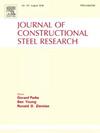自定心预应力钢管混凝土格构摇塔横向承载力研究
IF 4
2区 工程技术
Q1 CONSTRUCTION & BUILDING TECHNOLOGY
引用次数: 0
摘要
预应力钢管混凝土(CFST)格塔创新地将预应力与钢管混凝土结构结合起来,用于低风速地区的陆上风力发电塔,在这些地区,压弯荷载是主要荷载。为了研究预应力对这种新型塔结构抗震性能的影响,在预应力钢管混凝土格构塔底部不同边界条件下进行了压缩弯曲荷载下的拟静力尺度试验。分析了塔的破坏模式、荷载-位移滞回曲线、极限承载能力、能量耗散、刚度退化和预应力变化等力学性能参数,为优化塔的设计参数提供了建议。随后,利用试验结果推导的验证有限元模型,进行参数化分析,评估材料强度、试件尺寸、预应力对结构承载能力的影响,为优化塔的设计参数提供建议。在综合分析自定心预应力钢管混凝土格构摇塔在压弯载荷作用下的摇摆特性的基础上,结合刚体摇摆理论,建立了自定心预应力钢管混凝土格构摇塔横向承载能力的双线性简化计算模型。通过实验数据与有限元分析结果的对比,验证了理论计算方法的合理性。本文章由计算机程序翻译,如有差异,请以英文原文为准。
Lateral bearing capacity of self-centering prestressed concrete filled steel tubular lattice rocking tower
Prestressed concrete filled steel tubular (CFST) lattice tower innovatively combines prestressing with CFST structures for onshore wind turbine towers in low wind speed regions, where compression-bending loads constitute the predominant load during the design process. To investigate influences of prestressing on seismic performances of such novel tower structures, pseudo-static scaled experiments were conducted under compression-bending loads by varying boundary conditions at the base of prestressed CFST lattice tower. The analysis focused on several mechanical performance parameters, including failure modes, load-displacement hysteretic curves, ultimate load capacity, energy dissipation, stiffness degradation, and prestress variations, thus providing recommendations for optimizing design parameters of the tower. Subsequently, employing the validated finite element (FE) model derived from experimental results, parametric analysis was performed to evaluate effects of material strength, specimen dimensions, and prestressing on structural load-carrying capacity, thus providing recommendations for optimizing the design parameters of the tower. Drawing upon comprehensive analysis of rocking behavior for self-centering prestressed CFST lattice rocking tower subjected to compression-bending loads, alongside rigid body rocking theory, a bilinear simplified calculation model was developed for deriving lateral load-carrying capacity of such rocking structure. The rationality of the proposed theoretical calculation method was substantiated through comparisons of experimental data and FE analysis results.
求助全文
通过发布文献求助,成功后即可免费获取论文全文。
去求助
来源期刊

Journal of Constructional Steel Research
工程技术-工程:土木
CiteScore
7.90
自引率
19.50%
发文量
550
审稿时长
46 days
期刊介绍:
The Journal of Constructional Steel Research provides an international forum for the presentation and discussion of the latest developments in structural steel research and their applications. It is aimed not only at researchers but also at those likely to be most affected by research results, i.e. designers and fabricators. Original papers of a high standard dealing with all aspects of steel research including theoretical and experimental research on elements, assemblages, connection and material properties are considered for publication.
 求助内容:
求助内容: 应助结果提醒方式:
应助结果提醒方式:


